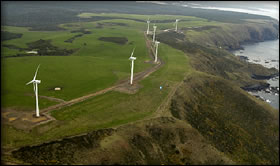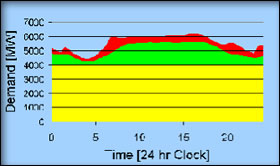 The Scientist: The Scientist:
Cameron Potter BE(Hons)
School of Engineering, University of Tasmania, & Hydro Tasmania
Mention artificial intelligence and most people’s minds will be drawn to thoughts of robots behaving like humans, but Cameron Potter is using this greatly misunderstood technology to get the most out of renewable energy sources.
Cameron completed a Degree in communications engineering and gained Honours in power engineering, before beginning his PhD, all at the University of Tasmania.
In technical terms, his PhD focuses on optimal dispatch for hydro and wind power generation, while in layman’s terms it is looking into the use of artificial intelligence applications in power systems. It is a subject Cameron chose after casual employment with Hydro Tasmania drew his attention to the value of power.
“In the world there is a rising demand for power, but there’s not always the power to meet it, for example during the New York blackout of 2003,” Cameron says. “As resources run low, the world is looking for new and environmentally friendly solutions to power generation.”
Cameron is working closely with the University, due to its high level of expertise, and Hydro Tasmania, which is set to benefit from his work but is also allowing him to retain the valuable intellectual property on the research. He says that although wind farm development is on the rise, nobody has the technology to accurately predict the short-term energy available from this form of power generation.
“Because of the nature of wind, in five minutes you can lose 50 per cent of the energy,” he says. “If you lost that much total power in a power grid, without expecting it, you could have power blackouts every 15 minutes.”
Cameron believes that the answer could lie in artificial intelligence, which originated in the 60s and 70s alongside the ground-breaking development of computers that could emulate thought and make decisions.
“Artificial intelligence allows you to control and model things that are extremely complex. It’s everywhere - you can’t buy electrical goods that don’t have some type of artificial intelligence, even just a timer on a rice cooker that makes the decision that the rice is cooked is a form of A.I. [artificial intelligence]. I like the idea of making a machine do something of which it wouldn’t normally be capable.”
Cameron said that his research involves working with Hydro Tasmania to develop a system to enable better wind prediction for a more stable power system.
“In reality, power is an amorphus blob – it doesn’t matter to the user how it is produced, just as long as electricity is there,” he says. “Wind power is clean and under utilised but has a problem of maintaining a stable base. Trying to control a power system with 20 per cent wind power has been described as like driving an articulated lorry without steering or brakes - very difficult!”
“This research project is about trying to provide the steering wheel and brakes. You can’t control the wind, but you can try to predict what the wind will do.”
Cameron says that the use of artificial intelligence in this area is a new development.
“No-one has used this method in wind forecasting before; instead they’ve used mathematics, rules and breeding solutions.”
More About the Work
Key words: Artificial intelligence, Renewable energy
What is A.I? Artificial intelligence is a science that attempts to enable machines to do things, that would require intelligence to be done by a human. The first successful intelligence systems were “expert systems”. Creating these involved taking the knowledge of an expert and using it to develop heuristics (if-then rules) that the computer can apply. These are useful as an experts knowledge is not lost, and often the tasks assigned to the expert system are menial tasks that don’t warrant the time of the expert, yet need the experts knowledge to complete.
What is Renewable Energy? Renewable energy is a source of energy that can be tapped and yet will not degrade or become depleted. Most renewable energy comes from the elements of the earth. The sun provides solar power, the wind provides wind generation and water provides various forms of hydro power. There are several key points to renewable energy. It does not produce greenhouse emissions and it is cost effective (once installed), however, the installation costs are high, making such constructions an expensive option. The other major issue is that as these systems rely upon energy coming from uncontrolled sources, accurate prediction is essential.
Why is Renewable Energy so important Especially to Tasmania? The use of renewable energy makes sense on a global scale as it is environmentally neutral while traditional sources (such as fossil fuels) are not sustainable and have detrimental effects on the environment. However, in order to be able to compete, a power generator must be cost efficient. In time, more countries will insist upon renewable energy as pressure builds, but until then, a renewable generator in a deregulated (non-controlled) market will have to compete with all other electricity producers. Tasmania will soon be connecting to the national grid of Australia (Basslink) and this means that Hydro Tasmania will have to compete with fossil fuel based generators.
Specifics of The Research Several breakthroughs have been achieved such that the forecasts being obtained over very short periods are significantly better than the approaches that are presently being used. The reason for this is due to the structure of the system being used. It very closely models the way a human thinks and can learn and then draw general conclusions (on a very small area of interest). This technique is called an artificial neural fuzzy inference system. It works in two steps, the first step takes in the data and finds mathematical patterns that fit the data as well as possible. Then it creates fuzzy rules, which are basically similar to yes/no questions, but instead can handle various levels of “correctness”.

A Windfarm at Woolnorth, northwestern Tasmania
Websites
Wind Power Resources
https://www.bwea.com/edu/teachers.html
Renewable and Non-Renewable Energy Sources Energy Information Administration
https://www.eia.doe.gov/kids/kidscorner.html
Making Wind Power More Efficient
https://www.innovations-report.com/html/ reports/energy_engineering/report-19063.html
Hydro Tasmania
https://hydro.com.au
School of Engineering, University of Tasmania
https://www.utas.edu.au/eng
Overview of Power System Operations

The demand for power over a 24hr period can be broken down into three parts:
The BASE load is the load that is constantly there. It is best thought of as the power that must be supplied at all times of the day.
The MIDDLE load makes up for the major peaks and troughs of the daily load pattern. It changes, but not too quickly.
The PEAK load is a small but varying load that accounts for the small fluctuations in demand. A generator must be able to adapt to changing situations very rapidly in order to efficiently supply peak load.
|
